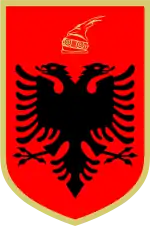Albania–Yugoslavia relations
Albania–Yugoslavia relations were historical foreign relations between Albania (both Kingdom of Albania 1928-1939 and the People's Socialist Republic of Albania 1946-1992) and now broken up Yugoslavia (Kingdom of Yugoslavia 1918-1941 and Socialist Federal Republic of Yugoslavia 1945-1992). With occasional periods of friendly relations or efforts to improve relations, the two countries predominantly maintained cold or openly hostile relations. The period of close relations developed right after the end of the World War II when Yugoslavia pushed for socioeconomic integration of Albania into Yugoslavia within the Balkan Federation (bargaining with the idea of unification of Albania with kinship region of Kosovo), but they turned into sharp antagonism after the 1948 Tito–Stalin split.[1]
 | |
Albania |
Yugoslavia |
|---|---|
History

Albanian early relations with Yugoslavia were preceded by its prior relations with the Kingdom of Serbia and the Kingdom of Montenegro and the experience of Dissolution of the Ottoman Empire in the Balkans. Predominantly Eastern Orthodox Balkan nations gained their independence a couple of decades before Albania so that the Albanian National Awakening was faced with state-building and regional balance of power games fueled by conflicting nationalist claims.[2] This situation reached it peak at the time of the First Balkan War in which regional powers of Kingdom of Bulgaria, Kingdom of Serbia, Kingdom of Greece and Kingdom of Montenegro divided among themselves the remaining European territory of the Sick man of Europe. While their earlier efforts were fueled with the intention of national liberation, during the First Balkan War regional balance of power played more prominent role in decision making so that Albanian territories were divided by its neighbors. At the same time Albanian state started to develop, and due to concern of Great Powers over the Russian expansion into Mediterranean the independent Principality of Albania was created along the cost. This state however did not include Albanian inhabited region of Kosovo as well as numerous Albanian population in modern-day North Macedonia, Montenegro and Greece. The border remained unclear all trough the World War I (when Serbian Albanian Golgotha took place) and in early years after the establishment of the Kingdom of Yugoslavia (which was created after Serbia united with Montenegro, Banat, Bačka and Baranja and the State of Slovenes, Croats and Serbs). Subsequent to 1948 Yugoslavia developed comparatively open Titoist system economically linked to Western Europe and diplomatically active with Non-bloc countries. Albania was on the other hand highly self-isolated aytarkyc states, especially following the Soviet–Albanian split and Sino-Albanian split.
Kingdom of Yugoslavia relations with Albania
In 1921 Kingdom of Yugoslavia supported the establishment of the Republic of Mirdita in it efforts to push for more advantageous border demarcation for Yugoslavia.[2] The Conference of Ambassadors decided to deal with the issue of Albanian-Yugoslav border and it published them soon after the creation of Republic of Mirdita yet the United Kingdom insisted on slight adaptations in the region of Debar, Prizren and Kastrati in the interest of Yugoslavia.[2] In an effort to gain the favor of the Border Demarcation Commission two countries established formal diplomatic relations in March 1922.[2]
World War II
During the World War II Italian protectorate of Albania and subsequent German occupation of Albania created effective Axis client state of Greater Albania which covered parts of Yugoslavia and persecuted local non-Albanian population.[3] National Liberation Movement of Albania closely cooperated and was significantly influenced by the Yugoslav Partisans.[3]
Relations after the World War II
Following the end of World War II Yugoslavia was reorganized as the socialist federation of six constituent federal subject republics. In addition, within the Socialist Republic of Serbia two autonomous regions were created one of which was the Autonomous Region of Kosovo and Metohija with ethnic Albanian majority. In July 1946, Yugoslavia and Albania signed the Treaty of Friendship and Cooperation followed by a series of technical and economic agreements aimed at integration of the Albanian and Yugoslav economies.[1] Serbo-Croatian became a required subject in Albanian high schools at that time.[1] At the Party of Labour of Albania plenum in February and March 1948 leadership voted to merge the Albanian and Yugoslav economies and militaries while Koçi Xoxe proposed appealing to Belgrade to admit Albania as a seventh Yugoslav republic.[1] Relations turned into sharp antagonism after the 1948 Tito–Stalin split.
See also
References
- Raymond Zickel and Walter R. Iwaskiw, editors (1994). "Albania: A Country Study: Albanian-Yugoslav Tensions". Washington: GPO for the Library of Congress. Retrieved 25 September 2020.
- Vladan Jovanović (7 November 2014). "Pregled istorije odnosa Srbije/Jugoslavije i Albanije". Peščanik. Retrieved 25 September 2020.
- Bartul Čović (31 December 2019). "Jugoslavija nije Galsko selo". Slobodni Filozofski. Retrieved 25 September 2020.

